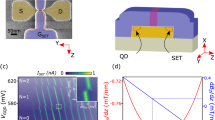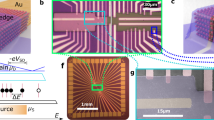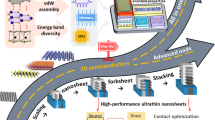Abstract
Devices in which the transport and storage of single electrons are systematically controlled could lead to a new generation of nanoscale devices and sensors1,2,3. The attractive features of these devices include operation at extremely low power, scalability to the sub-nanometre regime and extremely high charge sensitivity4,5,6,7,8,9. However, the fabrication of single-electron devices requires nanoscale geometrical control, which has limited their fabrication to small numbers of devices at a time9,10,11,12,13,14,15, significantly restricting their implementation in practical devices. Here we report the parallel fabrication of single-electron devices, which results in multiple, individually addressable, single-electron devices that operate at room temperature. This was made possible using CMOS fabrication technology and implementing self-alignment of the source and drain electrodes, which are vertically separated by thin dielectric films. We demonstrate clear Coulomb staircase/blockade and Coulomb oscillations at room temperature and also at low temperatures.
This is a preview of subscription content, access via your institution
Access options
Subscribe to this journal
Receive 12 print issues and online access
$259.00 per year
only $21.58 per issue
Buy this article
- Purchase on Springer Link
- Instant access to full article PDF
Prices may be subject to local taxes which are calculated during checkout





Similar content being viewed by others
References
Averin, D. V. & Likharev, K. K. in Mesoscopic Phenomena in Solids (eds. Altshuler, B. L., Lee, P. A. & Webb, R. A.) 173–271 (Elsevier, Amsterdam, 1991).
Kastner, M. A. The single-electron transistor. Rev. Mod. Phys. 64, 849–858 (1992).
Likharev, K. K. Single-electron devices and their applications. Proc. IEEE 87, 606–632 (1999).
Devoret, M. H. & Schoelkopf, R. J. Amplifying quantum signals with the single-electron transistor. Nature 406, 1039–1046 (2000).
Park, J. et al. Coulomb blockage and the Kondo effect in single-atom transistors. Nature 417, 722–725 (2002).
Liang, W., Shores, M. P., Bockrath, M., Long, J. R. & Park, H. Kondo resonance in a single-molecule transistor. Nature 417, 725–729 (2002).
Knobel, R. G. & Cleland, A. N. Nanometre-scale displacement sensing using a single electron transistor. Nature 424, 291–293 (2003).
Park, H. et al. Nanomechanical oscillations in a single-C60 transistor. Nature 407, 57–60 (2000).
Andres, R. P. et al. “Coulomb staircase” at room temperature in a self-assembled molecular nanostructure. Science 272, 1323–1325 (1996).
Klein, D. L., Roth, R., Lim, A. K. L., Alivisatos, A. P. & McEuen, P. L. A single-electron transistor made from a cadmium selenide nanocrystal. Nature 389, 699–701 (1997).
Bolotin, K. I., Kuemmeth, F., Pasupathy, A. N. & Ralph, D. C. Metal-nanoparticle single-electron transistors fabricated using electromigration. Appl. Phys. Lett. 84, 3154–3156 (2004).
Deshmukh, M. M., Prieto, A. L., Gu, Q. & Park, H. Fabrication of asymmetric electrode pairs with nanometre separation made of two distinct metals. Nano Lett. 3, 1383–1385 (2003).
Matsumoto, K. et al. Room temperature operation of a single electron transistor made by the scanning tunnelling microscope nanooxidation process for the TiOx/Ti system. Appl. Phys. Lett. 68, 34–36 (1996).
Nijhuis, C. A. et al. Room-temperature single-electron tunnelling in dendrimer-stabilized gold nanoparticles anchored at a molecular printboard. Small 2, 1422–1426 (2006).
Persson, S. H. M., Olofsson, L. & Gunnarsson, L. A self-assembled single-electron tunnelling transistor. Appl. Phys. Lett. 74, 2546–2548 (1999).
Davidovic, D. & Tinkham, M. Spectroscopy, interactions and level splittings in Au nanoparticles. Phys. Rev. Lett. 83, 1644–1647 (1999).
Parks, J. J. et al. Tuning the kondo effect with a mechanically controllable break junction. Phys. Rev. Lett. 99, 026601 (2007).
Reed, M. A., Zhou, C., Muller, C. J., Burgin, T. P. & Tour, J. M. Conductance of a molecular junction. Science 278, 252–254 (1997).
Park, H., Lim, A. K. L., Alivisatos, A. P., Park, J. & McEuen, P. L. Fabrication of metallic electrodes with nanometre separation by electromigration. Appl. Phys. Lett. 75, 301–303 (1999).
Kervennic, Y. V., Van der Zant, H. S. J., Morpurgo, A. F., Gurevich, L. & Kouwenhoven, L. P. Nanometre-spaced electrodes with calibrated separation. Appl. Phys. Lett. 80, 321–323 (2002).
Kimura, Y. et al. Room-temperature observation of a Coulomb blockade phenomenon in aluminum nanodots fabricated by an electrochemical process. Appl. Phys. Lett. 90, 093119 (2007).
Yasutake, Y. et al. Simultaneous fabrication of nanogap gold electrodes by electroless gold plating using a common medical liquid. Appl. Phys. Lett. 91, 203107 (2007).
Ah, C. S. et al. Fabrication of integrated nanogap electrodes by surface-catalyzed chemical deposition. Appl. Phys. Lett. 88, 133116 (2006).
Krahne, R. et al. Fabrication of nanoscale gaps in integrated circuits. Appl. Phys. Lett. 81, 730–732 (2002).
Smith, R. K., Lewis, P. A. & Weiss, P. S. Patterning self-assembled monolayers. Prog. Surf. Sci. 75, 1–68 (2004).
Ma, L.-C. et al. Electrostatic funnelling for precise nanoparticle placement: A route to wafer-scale integration. Nano Lett. 7, 439–445 (2007).
Danilov, A. V., Golubev, D. S. & Kubatkin, S. E. Tunnelling through a multigrain system: Deducing sample topology from nonlinear conductance. Phys. Rev. B 65, 125312 (2002).
Hanna, A. E. & Tinkham, M. Variation of the Coulomb staircase in a 2-junction system by fractional electron charge. Phys. Rev. B 44, 5919–5922 (1991).
Wang, B. et al. Tunable single-electron tunnelling behaviour of ligand-stabilized gold particles on self-assembled monolayers. Phys. Rev. B 63, 035403 (2001).
Acknowledgements
We thank N. Michael for discussions. This work was supported by the Office of Naval Research (N00014-05-1-0030), National Science Foundation CAREER Award (ECS-0449958) and Advanced Research Program of Texas Higher Education Coordinating Board (003656-0014-2006).
Author information
Authors and Affiliations
Contributions
S.J.K., V.R., R.S. and C.-U.K. conceived and designed the experiments. V.R., R.S., P.B. and L.-C.M. performed the experiments. V.R. and S.J.K. analysed the data. S.J.K., V.R. and C.-U.K. wrote the paper. S.J.K. supervised all aspects of the project. All authors discussed the results and commented on the manuscript.
Corresponding author
Supplementary information
Supplementary Information
Fig.1 to Fig.3 (PDF 197 kb)
Rights and permissions
About this article
Cite this article
Ray, V., Subramanian, R., Bhadrachalam, P. et al. CMOS-compatible fabrication of room-temperature single-electron devices. Nature Nanotech 3, 603–608 (2008). https://doi.org/10.1038/nnano.2008.267
Received:
Accepted:
Published:
Issue Date:
DOI: https://doi.org/10.1038/nnano.2008.267
This article is cited by
-
High-yield parallel fabrication of quantum-dot monolayer single-electron devices displaying Coulomb staircase, contacted by graphene
Nature Communications (2021)
-
Design strategy and simulation of single-gate SET for novel SETMOS hybridization
Journal of Computational Electronics (2021)
-
Mechanical gate control for atom-by-atom cluster assembly with scanning probe microscopy
Nature Communications (2014)
-
Energy-filtered cold electron transport at room temperature
Nature Communications (2014)
-
Single electron effects in silicon quantum devices
Journal of Nanoparticle Research (2013)



